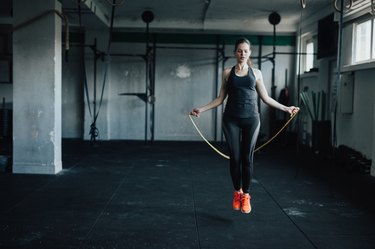
Pain in a calf muscle can leave you struggling to walk, much less able to complete an exercise like jumping rope. Most calf pain is the result of strains or contusions in the calf.
You can take certain measures to relieve your pain based on the severity of the injury in addition to adding a few stretches and exercises to prevent calf pain from coming back. If your pain persists, see your doctor.
Video of the Day
Video of the Day
Calf Muscle Strains
Jumping rope requires repetitive use of the muscles that raise you up on your toes and allow you to jump. This group of muscles, called plantar flexors, are located in your calf. Activities such as jumping rope can strain your calf muscles — particularly if you are new to this exercise.
According to the Sports Injury Clinic, calf strains are graded on a 1, 2 or 3 scale. The Grade 1 strains are the least severe, with up to 10 percent of the muscle fibers torn, while grade 2 strains involve tears of up to 90 percent of the muscle fibers. Grade 3 strains are complete tears or full ruptures that usually occur at the knee or Achilles tendon.
Grade 1 strains are the most common, and athletes can often continue through the light to moderate pain this type of strain causes. Grade 2 strains are more severe and often lead to pain that prevents exercise. Grade 3 produce severe pain and sometimes muscle dislocation.
Contusions and Cramps
Muscle contusions or bruises can cause pain in your calf especially during movement or flexing of the muscle. Calf contusions are also graded on a 1 to 3 scale, with 1 being the most minor and 3 being a severe, internal-bleeding injury. Cramps in your calf muscle can also cause significant pain during exercise. A cramp is a painful involuntary muscle contraction that commonly occurs in calves.
Causes of Calf Pain
Contusions result from a hit or bump on the calf that leads to swelling and pain. Cramps are usually caused by dehydration, low potassium levels, low sodium levels or low carbohydrate levels. Calf strains can result from a variety of injuries, such as overuse or soreness from training.
Playing sports or exercising can also lead to a calf injury, especially if you have tight muscles. Add stretches to your routine before and after jumping rope to help with flexibility.
Read more: Balanced Weekly Meal Plan
Treatment and Prevention
Rest, apply ice, apply compression and elevate your calf injury to aid recovery. In the case of cramps, staying hydrated and eating a balanced diet full of nutrients can help prevent and relieve cramps. Stretching and strengthening your calves can prevent future injuries. Calf raises are the best strengthening exercises for calves. Slowly build up your repetitions to avoid overworking calf muscles.
Use proper technique when jumping rope to help prevent injury. Jump and land with soft knees, keeping them slightly bent throughout the movement. Look straight ahead and stand up tall with your elbows close to your sides. Only jump high enough to clear the rope.
Read more: How to Treat Sore Calves